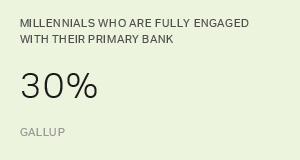Story Highlights
- Customers' experiences affect their receptiveness to wellbeing messaging
- Recent Gallup research examines several demographic differences
- Banks have an opportunity to tailor services and delivery to individual needs
Customers who feel their bank looks out for them are far more profitable and loyal.
However, there is no single approach that supports all customers' financial wellbeing equally. The right approach supplies whatever your customers need. Does that sound subjective? Sure. Contextual? Definitely. Impossible to deliver? Actually, no.
According to Gallup's recent financial services industry research, customers report higher levels of financial wellbeing when they can strongly agree that their bank:
- helps them reach their financial goals
- understands their financial situation
- makes it easy for them to manage their finances
- helps them make better financial decisions
- looks out for their financial wellbeing
- offers solutions to meet their financial needs
- puts their financial wellbeing ahead of the interests of the bank
- has their best interests at heart
Those elements are consistent across every consumer banking segment -- retail, insurance and wealth management -- that Gallup has studied.
However, Gallup has found differences according to bank customers' demographics, including gender, marital status, race/ethnicity and age/generation.
This means that bankers who are serious about supporting their customers' perceptions of financial wellbeing should know that their customers' subjective, contextual viewpoints and experiences can vary quite a bit. Those experiences may impact customers' receptiveness to a bank's financial wellbeing strategy and service delivery.
Gender
Women are more likely than men to feel supported in their financial wellbeing, perhaps because they find more opportunities to be supported. More women than men -- 81.8% vs. 78.1% of men -- initiated their last sales conversation with a banker. These kinds of conversations allow banks to individualize products to customers and extend services that can promote a feeling of financial wellbeing.
Marital Status
Customers who have been married report more financial wellbeing support from their banks than do unmarried customers. Again, this response may be related to the fact that marriage can prompt conversations with bankers about mortgages, college loans, retirement planning and insurance packages. Bankers may not have these kinds of conversations with single people as often.
Lending weight to the hypothesis that married people's sense of their bank's efforts to support their financial wellbeing is more related to conversations with bankers than refracted marital bliss is this data point. The widowed and divorced are even more likely than the currently married to strongly agree with at least four of the financial wellbeing statements regarding their primary bank.
A disruption in finances -- such as the loss of a spouse -- forces individuals to reevaluate their financial situation. For consumers to feel such support for their wellbeing after one of life's arguably most stressful events is a testament to the compassion that many bank employees offer their customers.
Race/Ethnicity
More white customers strongly agree with four or more of the financial wellbeing statements than customers in any other racial or ethnic group. African-American women are much less likely than white women to strongly agree with at least four of the financial wellbeing statements.
Gallup has not researched the causes of these discrepancies, and so can't provide a scientifically valid explanation for them. However, researchers have determined that African-Americans and Latinos are denied conventional mortgage loans more often than are white customers. People of color have been singled out for subprime loans on the basis of race when they qualified for less expensive loans. Entry-level products like checking accounts have been found to cost more in areas with high nonwhite populations, among other racialized disparities. Also, most bank employees, especially those in leadership positions, are not members of ethnic minorities, which may have some impact on downstream customer perceptions.
Though the financial services industry may be no more likely than any other to be affected by racism -- and operates under far more anti-discrimination regulations than many -- any hint of racism in the industry could affect some customers' perceptions of banking. It could impact perceptions of a bank's understanding of individual needs, and its commitment to supporting the financial wellbeing of all customers.
Age/Generation
In general, older customers are likelier than younger customers to feel their bank supports their financial wellbeing.
Again, that might relate to the many more opportunities older customers have had to discuss products and services with a banker. The oldest members of Generation Z are in their early 20s, while the oldest Traditionalists are in their 90s. Between the two groups are 70 years of financial needs and questions and 18 percentage points of strong agreement that banks are committed to their customers' financial wellbeing.
Income and Employment Status
Bankers would be mistaken to think that older customers' wellbeing is related to having amassed greater wealth. Older people are not necessarily more lucrative customers. Gallup finds that high financial wellbeing is more a matter of perceived financial security than anything else. It's possible to have high wellbeing with $10 in your pocket and just as possible to have low wellbeing with $10 million in checking. Indeed, the data show that people of modest means have greater agreement with the financial wellbeing statements than do the wealthiest customers.
That finding may help explain, at least in part, why in general there is little relation between employment status, income and customers' perceptions that their bank supports their financial wellbeing.
Profession doesn't factor into the equation either. Customers most likely to feel wellbeing support from their bank are members of the military and clerical workers. People out of the workforce, such as homemakers and retirees, have higher financial wellbeing than any of the other categories of workers Gallup has studied. The wealthiest customers tend to be the least satisfied with their banks' financial wellbeing programs.
The only thing bankers should be certain of is that financial wellbeing is personal. The experiences of people in different demographic groups vary meaningfully. There is still work to be done to tailor services and service delivery to best meet the needs of different customer segments. Gallup's research shows that banks have a lot of opportunities there.
It can't be overemphasized: An individual's personal context shapes the solutions they need to support their financial wellbeing. Insightful, customized advice is the best way to deliver on that promise.
But segmentation models alone won't close the gap. They provide insight into customers' responses to their bank's products, services and programs, and in that they're very valuable. Those models are more useful, even predictive, when they're informed by Gallup data because they show bankers where to lean in, listen closer, have meaningful conversations and truly understand the needs of their customers.
Understanding how to improve the customer experience is key. It can't be overemphasized: An individual's personal context shapes the solutions they need to support their financial wellbeing. Insightful, customized advice is the best way to deliver on that promise. Overly generalized service standards will not improve the perception that the bank is looking out for the customer's financial wellbeing. Instead, bankers should seek to know how customers define financial wellbeing for themselves.
That definition is the only one that matters to a customer. It will help customers find the support they want -- and give the bank the competitive advantage of having a genuine financial welling program.
Get the context for customers' financial wellbeing:
- Attend the free webinar Gallup Banking Industry Study: Findings & Insights for more information about our research.
- Learn how Gallup's analytics and advice can help banking leaders better understand customer needs and expectations.
- Read our perspective paper How Millennials Want to Work and Live for more insights on how this demographic presents themselves as people, consumers and employees.




